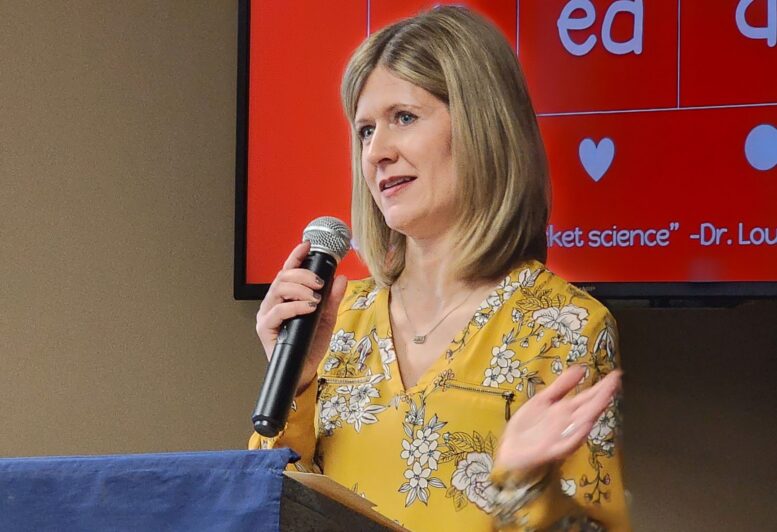By JAN McLAUGHLIN
BG Independent News
Even as an elementary student, Kristin Muir was planning to one day have her own classroom. She was thrilled when a teacher would ask her to lead the class down the hallway, or select her to read aloud the spelling quiz words.
“From a very young age, I always wanted to be a teacher,” said Muir, who was selected by the Bowling Green Kiwanis Club as an inspirational educator with Bowling Green City Schools.
Now, as the reading specialist at Kenwood Elementary, Muir’s thrill comes from seeing students learn to turn letters into sounds, put them together to form words, and comprehend their meaning.
The greatest feeling is watching students go from “learning to read to reading to learn,” she said during a presentation to the Kiwanis on Thursday.
Muir, a graduate of BGHS and BGSU, began teaching first grade at Ridge Elementary then at Crim Elementary.
Students at the first grade level are a joy, she said.
“They have so much energy and love learning things,” she said.
But she was motivated to become a reading specialist when she saw the number of students coming to kindergarten with skill levels lower than state standards. Muir’s job is to help close those gaps.
“I truly found my calling,” and is now in her sixth year as reading specialist at Kenwood, she said.
Muir works with K-3 students to build fundamental skills required for reading. To do that, students need routine, with some fun sprinkled in.
Researchers studying reading have found there’s a lot of science in the reading process – which has led many school districts to re-examine how reading is taught. While some districts are hesitant to adopt the “Science of Reading” program, Bowling Green City Schools is fully on board and has seen success in its early literacy test scores.
The “Science of Reading” recognizes that several parts of the brain must be fired up and connecting for word recognition and language comprehension, which result in reading comprehension.
“For many, reading the words on a page is very challenging,” Muir said.
To connect different areas of the brain, the students learn new letter or letter combination sounds by using mirrors to identify how they are using their mouths, lips and teeth to form the sounds.
To learn how to write the letters of the alphabet, students do “sky writing” and writing in sand, then progressing to paper. They work together to build words with letter cards.
To help her audience to understand the struggle of some young readers, Muir put a story on the screen, with occasional garbled words throughout the text. Grasping the content of the story is so difficult if the reader can’t make sense of the words, she explained.
But once students conquer the science of reading, they take it with them forever.
While honored to be recognized as an inspirational educator, Muir said she felt awkward accepting the award since much of her work is successful because of the teamwork of her fellow teachers, and help from the community.
“The work we are doing in our schools today is so impactful,” she said.

